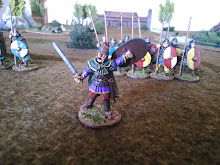Overview
Ok, so I have had the Force on Force (fof) rules by Ambush Ally for about a month now and have done some play tests with it. I have to say I'm very pleased with the rules.The rules are designed to be used for squad level combat from WW2 to present day (though mainly more for the last 25 years or so).
The book starts out with an overview of the turn sequence then it goes into a brief description of each component then later into a detailed description of each component. They start off with Infantry combat and at the end of that section provide a sample scenario you can play to use what you learned. Both the Vehicle and Air Support sections fallow the same pattern. Towards the end they provide additional optional rules to add more diversity to the game play.
Instead of basing actions off individual figures the game revolves around fire teams, usually consisting of 4 or more figures. A side might consist of 2-3 fire teams making up a squad. Line of sight, line of fire, cover, and movement are all based on the fire team as a whole and not the individual figures. Their is a big emphasis that the playing table is more of a representation of the battlefield as appose to an actual model. This means that buildings might have more entrances or firing points then depicted on the model, or that a figure occupies the area its placed in not the exact spot it sits on the table. This can be a confusing concept at first, specially if your use to having everything represented "As Seen". However, once you except the new concept you get a much more fluid and realistic game play.
Vehicles do not play as major a role in combat as in other games because the size of the game table is considered to be practically point blank for vehicles. While they are used and can be key to victory in some scenarios you wont find big armored battles like you might be use to in other games.
Likewise, Air units are very rarely ever represented on the table. The only example given in the rules where they would be used is when units are deploying from or be extracted by transport helicopters. As for air support no models are used as the rules explain that in real time they would either be so far away they would not appear on table or that they would fly through so fast that you could not represent them in the time flow of the game.
The game uses a universal system where your dice roles are always trying to get 4+ to succeed, sometimes this will be apposed by the opponent who will try to not only get a 4+ roll but a higher one then you. To represent the difference in quality of training, moral, and skill in soldiers units are given different dice levels. An average military unit from a first world nation might have a Troop Quality level of D8 which means for all their tests requiring Troop Quality they are rolling a D8 to try and get 4+. I feel this is a good way to distinguish the likelihood a unit is to succeed at something. The downside is you might need to buy some new dice as you will need about 10 of each type (D6, D8, D10, & D12).
Cons
There are a few typos in the beginning and one entire chart is missing. The chart can be found in a free down loadable Errata from the Ambush Ally website. The rules also take a few read through and play tests before they really start to click as they use an unfamiliar system.
Pros
- The Ambush Ally forums has a rules discussion section which is very helpful.
- They system used for play means there is never a time when a player is just sitting waiting for their turn to do something as you can react to every action your opponent makes.
- A game can be played with as few as 8 figures a side on a table no bigger then 2ft x 2ft.
- The book contains photo copyable Fog of War cards as well as extensive quick reference sheets, both of which can be downloaded for free from their site.







No comments:
Post a Comment